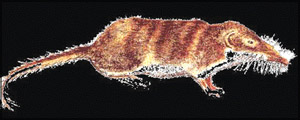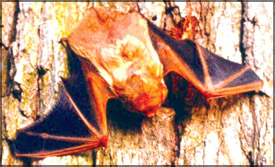|

Mammals with different traits
***
What
are mammals? They are the most recent of all the animal lineage,
believed to have evolved from an extinct group of reptiles some 200
million years ago, during the age of dinosaurs, according to scientists.
Mammals differ from other groups of animals due to many reasons.
Do you know how and
why they are different? Mammals are the only creatures that bring forth
live young and also feed them on secretions produced by the mammary
glands. In fact, the name mammal is derived from these special mammary
glands. By now, you must be aware that we humans too belong to this
group of animals.
However, these two
factors are not the only ones that make mammals different from other
animals. Mammals have hair or fur instead of feathers and scales, they
are able to maintain their body temperature at a constant level (even
birds can do so).They have sweat glands to help cool their bodies, and
also flexible skin. Today we feature some interesting facts about some
of these mammals.
***
Short-tailed Shrew
The only mammal with a venomous bite
|

Northern Short-tailed Shrew |
|

Southern Short-tailed Shrew |
This shrew is unique among the mammals in having glands in its mouth
that produce a powerful nerve poison: a single bite is sufficient to
kill a small mammal in a few seconds.
The Short-tailed Shrew (Blarina brevicauda) is one of just two
species of shrew-like insectivores that are found only in North America.
It spends most of its time in subterranean burrows and runways, but, in
winter, it may burrow through the surface snow cover as though it were
soil.
It hunts for its food on the surface and may even climb into bushes
in its search for tasty morsels. One was once observed climbing 1.9 m (6
ft) up a small tree to get at some suet placed in the fork of a branch.
The poison with which this small predator subdues (overcomes) its
prey is present in the saliva in its mouth, and seeps into the puncture
wounds made by its teeth when it bites its prey. The poison is so
powerful that it will leave a bite that is very painful for several days
even in an animal as large as a man.
To help see it through the winter when food is hard to find, the
shrew will sometimes hoard (store) snails, beetles and seeds.
Each individual occupies an area of about 0.12 ha (0.3 acres), where
it builds its nest of dry leaves under fallen logs or tree stumps.
Profile
Length: 75-105 mm (3-4
in), with a tail of 17-30 mm (0.5-1.2 in).
Weight: 15-30 g (0.5-1.0 oz).
Distribution: Throughout
southern Canada and most of the USA.
Habitat: All types of
terrestrial habitat.
Breeding: 3-9 young in a
litter; births can occur any time from early spring to
autumn; females may produce
several litters each year.
Diet: Invertebrates, small
vertebrates and some plant matter.
Longevity: 2.5 years.
Notes: Males can breed as
little as 50 days after birth.
Colugos - The mammal that wraps
itself in a cloak
Like a voluminous (bulky) cape, the thin flaps of skin between the
colugo's extremities have to be tucked up under its arms to avoid being
caught on twigs while the animal is climbing trees.
  The
two closely related species of colugo or flying lemur (Cynocephalus
volans and C. variegatus) are the only living representatives of their
order, the Dermoptera. Their relationship to other mammalian groups has
long been a source of mystery, and different authorities have classified
them with the true lemurs (in the order Primates) and with the
insectivores. The
two closely related species of colugo or flying lemur (Cynocephalus
volans and C. variegatus) are the only living representatives of their
order, the Dermoptera. Their relationship to other mammalian groups has
long been a source of mystery, and different authorities have classified
them with the true lemurs (in the order Primates) and with the
insectivores.
They are now generally considered to form a separate primitive order
of their own. Colugos are characterised by the loose flaps of skin that
join all their extremities, from the neck, through the wrists and ankles
to the tip of the tail. When the animal stretches out its limbs, these
flaps of skin form a taut (tightly drawn) gliding platform on which it
can 'fly.'
Almost helpless on the ground, colugos will try to climb any vertical
object near them. Once in a tree, they climb swiftly to the top and
launch themselves into the air in a long shallow dive, to land in a tree
or bush some distance away.
With their large gliding flaps, the colugos are the most efficient of
all the gliding mammals and can cover long distances. One was once
recorded as covering a horizontal distance of 136 m (147 yds) during
which it lost only 10-12 m (32.5-39 ft) in height.
Colugos have an unusual skull that possesses many primitive features.
The teeth are also unique in that some of them are shaped like small
combs: their function remains uncertain, though they may be used in
grooming or gnawing.
Profile
Length: 38-42 cm
(15.2-16.8 in), with a tail of 22-27 cm (8.8-10.8 in).
Weight: 1.0-1.75 kg (2.2-3.9
lb).
Distribution: Southeast Asia
and adjacent islands of East Indies.
Habitat: Forest.
Breeding: Single young born
in February-March.
Diet: Fruit, flowers, leaves.
Savi's Pygmy Shrew
The smallest non-flying mammal in the
world
Barely 35 mm (1.4 in) long and weighing less than 2 g (0.1 oz), the
pygmy shrew ranks as the real Tom Thumb of the mammal world.
Despite its diminutive size, Savi's Pygmy Shrew (Suncus etruscus),
also known as the Etruscan Shrew, belongs to the genus that also contains the largest of the true shrews.
belongs to the genus that also contains the largest of the true shrews.
Constantly on the go when active, it keeps up a constant shrill
chatter the function of which remains obscure (unclear). Though usually
to be found scurrying about in the grass, it has been known to jump
distances of 20 cm (8 in) - more than four times its own body length -
to seize grasshoppers and spiders with a rapid snatch.
The pygmy shrew is so small it can even creep into the holes made by
earthworms!
Profile
Length: 35-48 mm (1.4-2.0
in), with a 25-30 mm (about 1 in) tail.
Weight: 2 g (0.1 oz).
Distribution: Mediterranean
area, eastward into Asia as far as Malaya and southward into Africa as
far as the Cape.
Habitat: Grasslands.
Diet: Insects.
Red Bat
The world's hardiest flying mammal
When hibernating in winter, it can withstand its body tissues
freezing into ice at temperatures as low as - 26 degrees C (-15 degrees
F) without suffering any serious ill effects.
One of about a dozen species of red (or 'hoary') bats, the Red Bat (Lasiurus
borealis) is a member of the most widely distributed group of bats in the New World.
most widely distributed group of bats in the New World.
Red Bats roost singly or in small groups in trees and shrubs, where
they are well disguised against the tree-trunk. Their deep red colour
gives them an effective camouflage which functions especially well
during the autumn season, when they can easily be mistaken for dead
leaves.
In fact, when disturbed at roost, they will sway gently from side to
side in just the way a dead leaf does. Red Bats are particularly strong
fliers, being able to outfly any other bat. The female will often fly
while carrying two or three infants clinging to her fur, a load that can
easily exceed her own body weight.
Populations living in Canada and the northern USA migrate southwards
during the winter, some travelling as much as 2000 km (1250 miles) to
spend the winter in northern Mexico.
The Red Bat is, nonetheless, well adapted to cope with the low
temperatures that populations in the northern parts of the winter range
experience. They are the most heavily furred, have the lowest heart rate
at low temperatures, and have the highest red blood-cell count of any
bat.
When they do go into hibernation, they curl up into a ball so as to
minimise the area exposed to the cold.
Profile
Length: 50-90 mm (2.0-3.6
in), with a tail of 40-75 mm (1.6-3.0 in).
Weight: 6-30 g (0.2-1.0 oz).
Distribution: Throughout
North America and the Caribbean.
Habitat: Any well-wooded
areas.
Breeding: A single litter of
2-4 young produced in May-July.
Diet: Insects captured in
flight.
Notes: The only bat to
have more than 2 young in a litter.
Courtesy: Remarkable Animals
|
